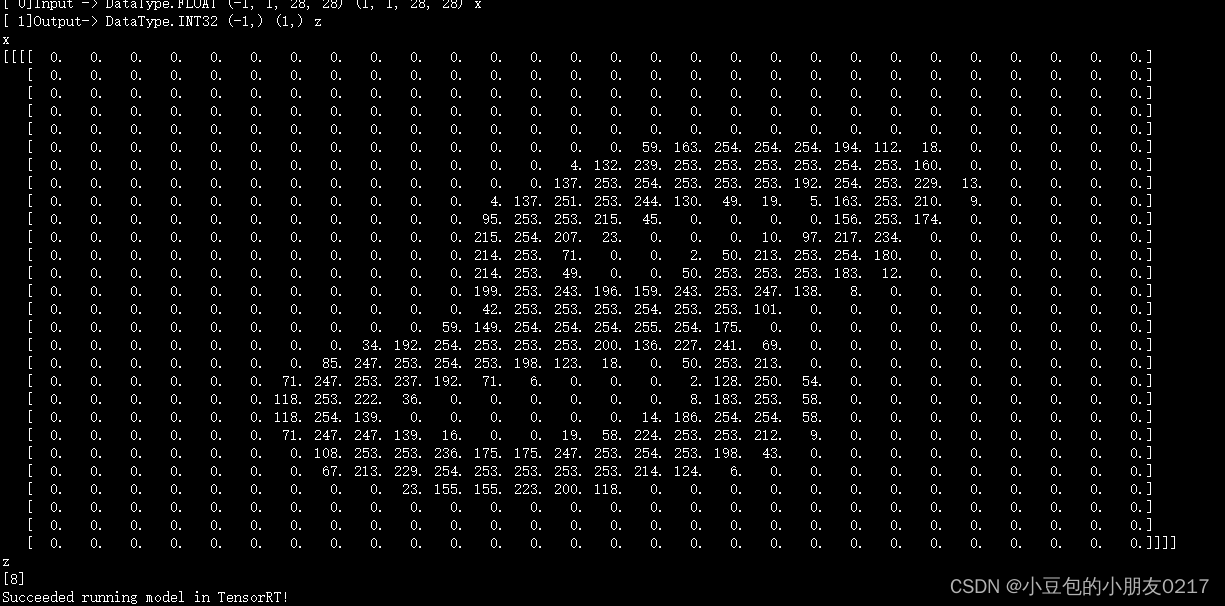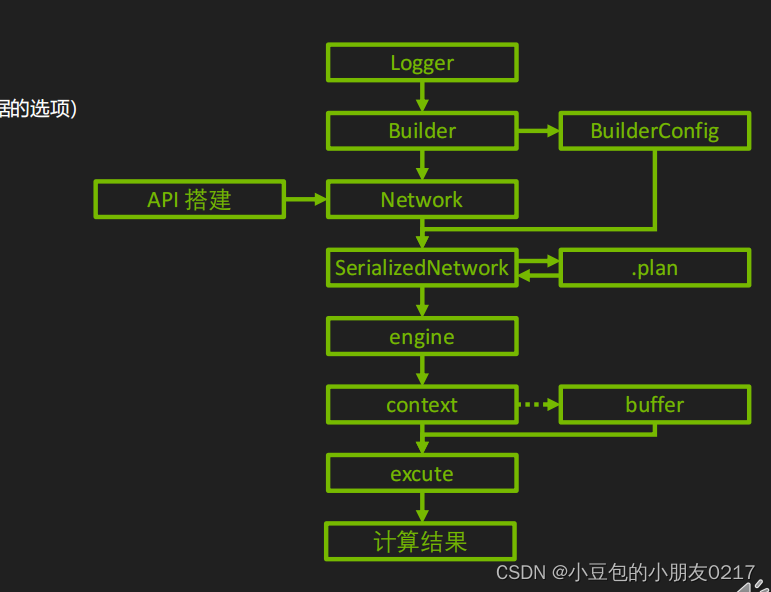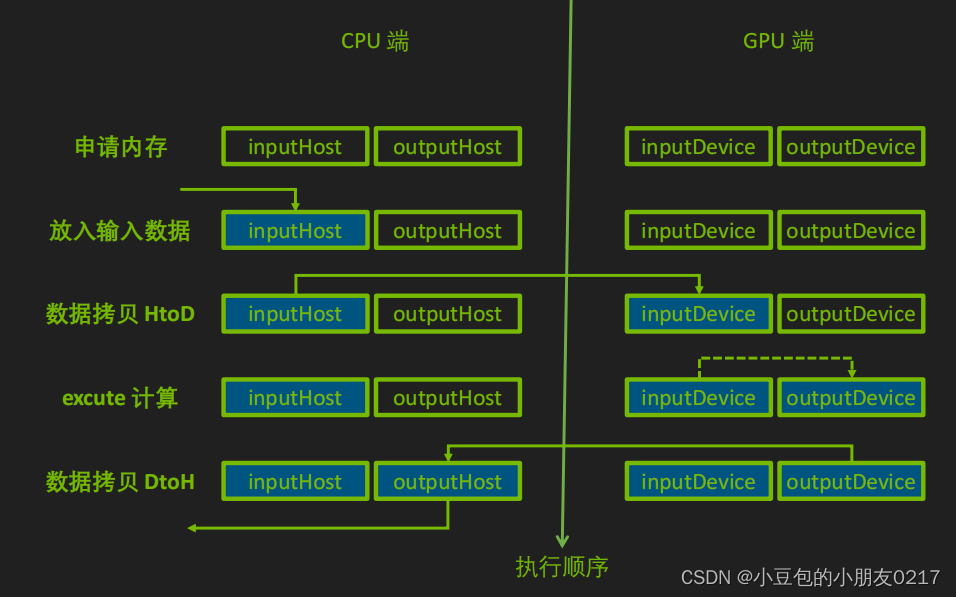TensorRT英伟达官方示例解析(三)
系列文章目录
TensorRT英伟达官方示例解析(一)
TensorRT英伟达官方示例解析(二)
TensorRT英伟达官方示例解析(三)
文章目录
前言
一、04-BuildEngineByONNXParser----pyTorch-ONNX-TensorRT
以pyTorch-ONNX-TensorRT为例
python3 main.py
#
# Copyright (c) 2021-2023, NVIDIA CORPORATION. All rights reserved.
#
# Licensed under the Apache License, Version 2.0 (the "License");
# you may not use this file except in compliance with the License.
# You may obtain a copy of the License at
#
# http://www.apache.org/licenses/LICENSE-2.0
#
# Unless required by applicable law or agreed to in writing, software
# distributed under the License is distributed on an "AS IS" BASIS,
# WITHOUT WARRANTIES OR CONDITIONS OF ANY KIND, either express or implied.
# See the License for the specific language governing permissions and
# limitations under the License.
#
import os
from datetime import datetime as dt
from glob import glob
import calibrator
import cv2
import numpy as np
import tensorrt as trt
import torch as t
import torch.nn.functional as F
from cuda import cudart
from torch.autograd import Variable
np.random.seed(31193)
t.manual_seed(97)
t.cuda.manual_seed_all(97)
t.backends.cudnn.deterministic = True
nTrainBatchSize = 128
nHeight = 28
nWidth = 28
onnxFile = "./model.onnx"
trtFile = "./model.plan"
dataPath = os.path.dirname(os.path.realpath(__file__)) + "/../../00-MNISTData/"
trainFileList = sorted(glob(dataPath + "train/*.jpg"))
testFileList = sorted(glob(dataPath + "test/*.jpg"))
inferenceImage = dataPath + "8.png"
# for FP16 mode
bUseFP16Mode = False
# for INT8 model
bUseINT8Mode = False
nCalibration = 1
cacheFile = "./int8.cache"
calibrationDataPath = dataPath + "test/"
os.system("rm -rf ./*.onnx ./*.plan ./*.cache")
np.set_printoptions(precision=3, linewidth=200, suppress=True)
cudart.cudaDeviceSynchronize()
# Create network and train model in pyTorch ------------------------------------
class Net(t.nn.Module):
def __init__(self):
super(Net, self).__init__()
self.conv1 = t.nn.Conv2d(1, 32, (5, 5), padding=(2, 2), bias=True)
self.conv2 = t.nn.Conv2d(32, 64, (5, 5), padding=(2, 2), bias=True)
self.fc1 = t.nn.Linear(64 * 7 * 7, 1024, bias=True)
self.fc2 = t.nn.Linear(1024, 10, bias=True)
def forward(self, x):
x = F.max_pool2d(F.relu(self.conv1(x)), (2, 2))
x = F.max_pool2d(F.relu(self.conv2(x)), (2, 2))
x = x.reshape(-1, 64 * 7 * 7)
x = F.relu(self.fc1(x))
y = self.fc2(x)
z = F.softmax(y, dim=1)
z = t.argmax(z, dim=1)
return y, z
class MyData(t.utils.data.Dataset):
def __init__(self, isTrain=True):
if isTrain:
self.data = trainFileList
else:
self.data = testFileList
def __getitem__(self, index):
imageName = self.data[index]
data = cv2.imread(imageName, cv2.IMREAD_GRAYSCALE)
label = np.zeros(10, dtype=np.float32)
index = int(imageName[-7])
label[index] = 1
return t.from_numpy(data.reshape(1, nHeight, nWidth).astype(np.float32)), t.from_numpy(label)
def __len__(self):
return len(self.data)
model = Net().cuda()
ceLoss = t.nn.CrossEntropyLoss()
opt = t.optim.Adam(model.parameters(), lr=0.001)
trainDataset = MyData(True)
testDataset = MyData(False)
trainLoader = t.utils.data.DataLoader(dataset=trainDataset, batch_size=nTrainBatchSize, shuffle=True)
testLoader = t.utils.data.DataLoader(dataset=testDataset, batch_size=nTrainBatchSize, shuffle=True)
for epoch in range(10):
for xTrain, yTrain in trainLoader:
xTrain = Variable(xTrain).cuda()
yTrain = Variable(yTrain).cuda()
opt.zero_grad()
y_, z = model(xTrain)
loss = ceLoss(y_, yTrain)
loss.backward()
opt.step()
with t.no_grad():
acc = 0
n = 0
for xTest, yTest in testLoader:
xTest = Variable(xTest).cuda()
yTest = Variable(yTest).cuda()
y_, z = model(xTest)
acc += t.sum(z == t.matmul(yTest, t.Tensor([0, 1, 2, 3, 4, 5, 6, 7, 8, 9]).to("cuda:0"))).cpu().numpy()
n += xTest.shape[0]
print("%s, epoch %2d, loss = %f, test acc = %f" % (dt.now(), epoch + 1, loss.data, acc / n))
print("Succeeded building model in pyTorch!")
# Export model as ONNX file ----------------------------------------------------
t.onnx.export(model, t.randn(1, 1, nHeight, nWidth, device="cuda"), onnxFile, input_names=["x"], output_names=["y", "z"], do_constant_folding=True, verbose=True, keep_initializers_as_inputs=True, opset_version=12, dynamic_axes={"x": {0: "nBatchSize"}, "z": {0: "nBatchSize"}})
print("Succeeded converting model into ONNX!")
# Parse network, rebuild network and do inference in TensorRT ------------------
logger = trt.Logger(trt.Logger.VERBOSE)
builder = trt.Builder(logger)
network = builder.create_network(1 << int(trt.NetworkDefinitionCreationFlag.EXPLICIT_BATCH))
profile = builder.create_optimization_profile()
config = builder.create_builder_config()
if bUseFP16Mode:
config.set_flag(trt.BuilderFlag.FP16)
if bUseINT8Mode:
config.set_flag(trt.BuilderFlag.INT8)
config.int8_calibrator = calibrator.MyCalibrator(calibrationDataPath, nCalibration, (1, 1, nHeight, nWidth), cacheFile)
parser = trt.OnnxParser(network, logger)
if not os.path.exists(onnxFile):
print("Failed finding ONNX file!")
exit()
print("Succeeded finding ONNX file!")
with open(onnxFile, "rb") as model:
if not parser.parse(model.read()):
print("Failed parsing .onnx file!")
for error in range(parser.num_errors):
print(parser.get_error(error))
exit()
print("Succeeded parsing .onnx file!")
inputTensor = network.get_input(0)
profile.set_shape(inputTensor.name, [1, 1, nHeight, nWidth], [4, 1, nHeight, nWidth], [8, 1, nHeight, nWidth])
config.add_optimization_profile(profile)
network.unmark_output(network.get_output(0)) # remove output tensor "y"
engineString = builder.build_serialized_network(network, config)
if engineString == None:
print("Failed building engine!")
exit()
print("Succeeded building engine!")
with open(trtFile, "wb") as f:
f.write(engineString)
engine = trt.Runtime(logger).deserialize_cuda_engine(engineString)
nIO = engine.num_io_tensors
lTensorName = [engine.get_tensor_name(i) for i in range(nIO)]
nInput = [engine.get_tensor_mode(lTensorName[i]) for i in range(nIO)].count(trt.TensorIOMode.INPUT)
context = engine.create_execution_context()
context.set_input_shape(lTensorName[0], [1, 1, nHeight, nWidth])
for i in range(nIO):
print("[%2d]%s->" % (i, "Input " if i < nInput else "Output"), engine.get_tensor_dtype(lTensorName[i]), engine.get_tensor_shape(lTensorName[i]), context.get_tensor_shape(lTensorName[i]), lTensorName[i])
bufferH = []
data = cv2.imread(inferenceImage, cv2.IMREAD_GRAYSCALE).astype(np.float32).reshape(1, 1, nHeight, nWidth)
bufferH.append(np.ascontiguousarray(data))
for i in range(nInput, nIO):
bufferH.append(np.empty(context.get_tensor_shape(lTensorName[i]), dtype=trt.nptype(engine.get_tensor_dtype(lTensorName[i]))))
bufferD = []
for i in range(nIO):
bufferD.append(cudart.cudaMalloc(bufferH[i].nbytes)[1])
for i in range(nInput):
cudart.cudaMemcpy(bufferD[i], bufferH[i].ctypes.data, bufferH[i].nbytes, cudart.cudaMemcpyKind.cudaMemcpyHostToDevice)
for i in range(nIO):
context.set_tensor_address(lTensorName[i], int(bufferD[i]))
context.execute_async_v3(0)
for i in range(nInput, nIO):
cudart.cudaMemcpy(bufferH[i].ctypes.data, bufferD[i], bufferH[i].nbytes, cudart.cudaMemcpyKind.cudaMemcpyDeviceToHost)
for i in range(nIO):
print(lTensorName[i])
print(bufferH[i])
for b in bufferD:
cudart.cudaFree(b)
print("Succeeded running model in TensorRT!")

生成了model.onnx和model.plan

生成 TRT 内部表示
engineString = builder.build_serialized_network(network, config)
if engineString == None:
print("Failed building engine!")
exit()
print("Succeeded building engine!")
with open(trtFile, "wb") as f:
f.write(engineString)
生成 Engine
engine = trt.Runtime(logger).deserialize_cuda_engine(engineString)
nIO = engine.num_io_tensors
lTensorName = [engine.get_tensor_name(i) for i in range(nIO)]
nInput = [engine.get_tensor_mode(lTensorName[i]) for i in range(nIO)].count(trt.TensorIOMode.INPUT)
创建 Context
context = engine.create_execution_context()
context.set_input_shape(lTensorName[0], [1, 1, nHeight, nWidth])
for i in range(nIO):
print("[%2d]%s->" % (i, "Input " if i < nInput else "Output"), engine.get_tensor_dtype(lTensorName[i]), engine.get_tensor_shape(lTensorName[i]), context.get_tensor_shape(lTensorName[i]), lTensorName[i])
Buffer

内存和显存的申请
? inputHost = np.ascontiguousarray(inputData) # 不要忘了 ascontiguousarray!
? outputHost = np.empty(context.get_tensor_shape(iTensorName[1]), trt.nptype(engine.get_tensor_dtype(iTensorName[1])))
? inputDevice = cudart.cudaMalloc(inputHost.nbytes)[1]
? outputDevice = cudart.cudaMalloc(outputHost.nbytes)[1]
? context.set_tensor_address(iTensorName[0], inputDevice)
? context.set_tensor_address(iTensorName[1], outputDevice)
内存和显存之间的拷贝
? cudart.cudaMemcpy(inputDevice, inputHost.ctypes.data, inputHost.nbytes, cudart.cudaMemcpyKind.cudaMemcpyHostToDevice)
? cudart.cudaMemcpy(outputHost.ctypes.data, outputDevice, outputHost.nbytes, cudart.cudaMemcpyKind.cudaMemcpyDeviceToHost)
推理完成后释放显存
? cudart.cudaFree(inputDevice)
? cudart.cudaFree(outputDevice)
bufferH = []
data = cv2.imread(inferenceImage, cv2.IMREAD_GRAYSCALE).astype(np.float32).reshape(1, 1, nHeight, nWidth)
bufferH.append(np.ascontiguousarray(data))
for i in range(nInput, nIO):
bufferH.append(np.empty(context.get_tensor_shape(lTensorName[i]), dtype=trt.nptype(engine.get_tensor_dtype(lTensorName[i]))))
bufferD = []
for i in range(nIO):
bufferD.append(cudart.cudaMalloc(bufferH[i].nbytes)[1])
for i in range(nInput):
cudart.cudaMemcpy(bufferD[i], bufferH[i].ctypes.data, bufferH[i].nbytes, cudart.cudaMemcpyKind.cudaMemcpyHostToDevice)
for i in range(nIO):
context.set_tensor_address(lTensorName[i], int(bufferD[i]))
context.execute_async_v3(0)
for i in range(nInput, nIO):
cudart.cudaMemcpy(bufferH[i].ctypes.data, bufferD[i], bufferH[i].nbytes, cudart.cudaMemcpyKind.cudaMemcpyDeviceToHost)
for i in range(nIO):
print(lTensorName[i])
print(bufferH[i])
for b in bufferD:
cudart.cudaFree(b)
二、04-BuildEngineByONNXParser----pyTorch-ONNX-TensorRT-QAT
pip install --no-deps pytorch_quantization
pip install -i https://pypi.tuna.tsinghua.edu.cn/simple pyyaml
python main.py
模型量化(Quantization):通过 PyTorch Quantization 库对模型进行量化,包括使用最大值校准器(max calibrator)或直方图校准器(histogram calibrator)。

Calibrate model in pyTorch ---------------------------------------------------
quant_modules.initialize()
with t.no_grad():
# turn on calibration tool
for name, module in model.named_modules():
if isinstance(module, qnn.TensorQuantizer):
if module._calibrator is not None:
module.disable_quant()
module.enable_calib()
else:
module.disable()
for i, (xTrain, yTrain) in enumerate(trainLoader):
if i >= nCalibrationBatch:
break
model(Variable(xTrain).cuda())
# turn off calibration tool
for name, module in model.named_modules():
if isinstance(module, qnn.TensorQuantizer):
if module._calibrator is not None:
module.enable_quant()
module.disable_calib()
else:
module.enable()
def computeArgMax(model, **kwargs):
for _, module in model.named_modules():
if isinstance(module, qnn.TensorQuantizer) and module._calibrator is not None:
if isinstance(module._calibrator, calib.MaxCalibrator):
module.load_calib_amax()
else:
module.load_calib_amax(**kwargs)
if calibrator == "max":
computeArgMax(model, method="max")
#modelName = "./model-max-%d.pth" % (nCalibrationBatch * trainLoader.batch_size)
else:
for percentile in percentileList:
computeArgMax(model, method="percentile")
#modelName = "./model-percentile-%f-%d.pth" % (percentile, nCalibrationBatch * trainLoader.batch_size)
for method in ["mse", "entropy"]:
computeArgMax(model, method=method)
#modelName = "./model-%s-%f.pth" % (method, percentile)
#t.save(model.state_dict(), modelName)
print("Succeeded calibrating model in pyTorch!")
这段代码展示了如何在 PyTorch 中进行模型校准(calibration)。模型校准是量化(quantization)的一部分,它用于确定量化操作的参数,例如最大值或百分位数。
首先,代码通过调用 initialize() 方法初始化量化模块。然后,通过遍历模型中的每个模块,找到需要进行量化的 TensorQuantizer 模块,并为其打开校准工具。
接下来,代码开始进行校准。通过遍历训练数据集中的一定数量的批次,使用模型对输入数据进行前向传播,以触发校准过程。在校准期间,量化模块的量化操作被禁用,而校准操作被启用。
校准完成后,代码关闭校准工具,并根据不同的校准方法计算和加载相应的校准参数。如果使用最大值校准器,会调用 load_calib_amax() 方法加载校准参数;如果使用百分位数校准器,还需指定百分位数的值。
最后,代码保存校准后的模型参数。根据不同的校准方法,会生成相应命名的模型文件。
模型量化相关可参考:https://blog.csdn.net/m0_70420861/article/details/135559743
总结
04-BuildEngineByONNXParser
本文来自互联网用户投稿,该文观点仅代表作者本人,不代表本站立场。本站仅提供信息存储空间服务,不拥有所有权,不承担相关法律责任。 如若内容造成侵权/违法违规/事实不符,请联系我的编程经验分享网邮箱:chenni525@qq.com进行投诉反馈,一经查实,立即删除!
- Python教程
- 深入理解 MySQL 中的 HAVING 关键字和聚合函数
- Qt之QChar编码(1)
- MyBatis入门基础篇
- 用Python脚本实现FFmpeg批量转换
- 通用图片转Excel与票证转为结构化数据的Excel识别有什么区别?
- Docker学习与应用(二)
- FreeRTOS学习--59讲 Tickless低功耗
- 前端网络面试:浏览器输入地址后发生了什么?
- 【二叉树线索化】(索引加速 | 标记附加域 | 三叉链表)
- CH32V307VCT6样片申请
- 大数据毕业设计:租房数据爬取分析可视化系统 K-means聚类算法 线性回归预测算法 机器学习(附源码)?
- 使用scipy处理图片——滤镜处理
- Java通过HttpClients发起GET、POST、PUT、DELETE、文件上传,文件下载,工具类HttpClientUtil
- 如何回答好“测得怎么样了?”